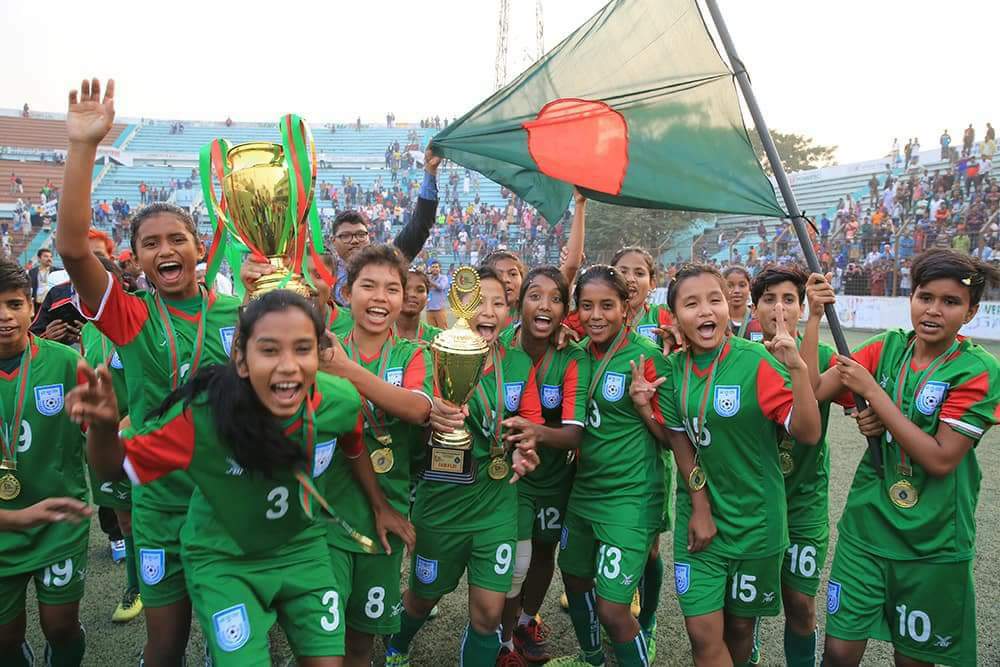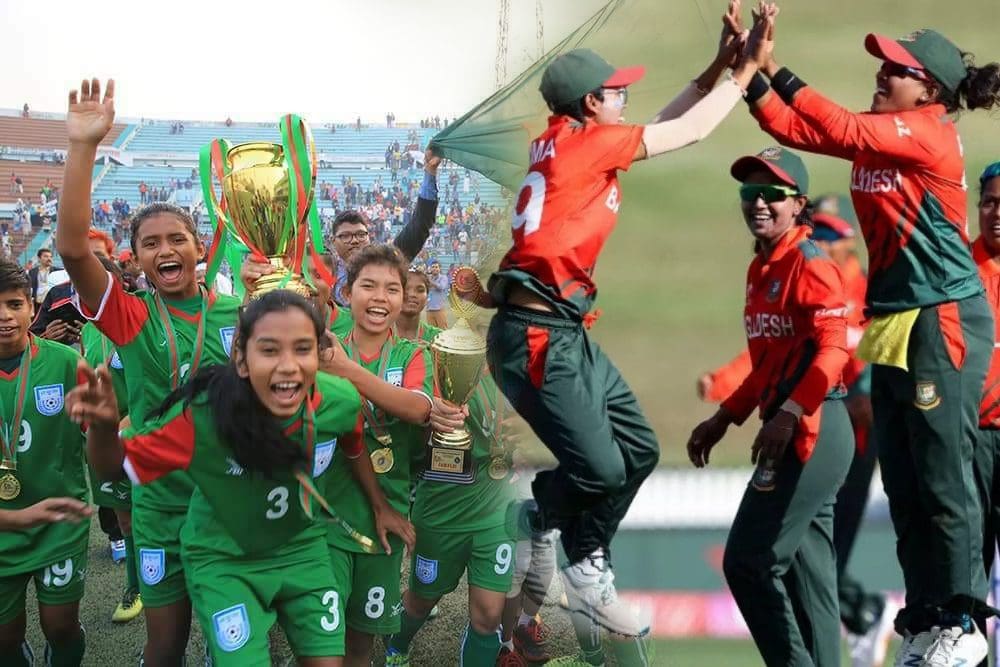Bangladesh has recently become the champions of SAFF Women’s Championship in 2022. The national women’s cricket team has defeated India a few days ago. However, we have also noticed assault targeted at female footballers in recent days. What more can the policymakers do to ensure equality of opportunity?
Football and Cricket are two of the most popular sports around the globe. With an estimated 3.5 billion and 2.5 billion fans, respectively, the two sports triumph over every other sport from the perspective of Bangladesh, not only in terms of viewership but also when it comes to people enthusiastic about playing the games. However, there already exists a huge gender gap when it comes to these sports, which accounts for not only the social stigma about the games but also the wide-spread disparity prevalent in the salaries as well as the requisite infrastructure.
Women’s Cricket and Football in Bangladesh: A Brief History and Integration into the Mainstream
Cricket has been played in the territory of present-day Bangladesh since the 18th century; however, it was not until our independence and the emergence of Bangladesh that the game garnered popularity. From the 1990s on, the Bangladesh Men’s team truly became a fan favourite throughout the country. However, cricket for women in Bangladesh progressed a bit slowly, with the team making their international debut in 2007. The team didn’t have to look back ever since, as they went on to win the 2007 ACC Women’s Tournament in the same year. The team gained its ODI status in 2011 and, so far, has participated in the 2022 World Cup. However, the best success of the team came in the 2018 Women’s Asia Cup, where they were eventually crowned Champions after beating India in the finals, something that even the Men’s team has failed to accomplish.

Football, like cricket, which has been played in this area since British rule, didn’t gain much adulation before the 1930s, when a lot of football tournaments were arranged in East Bengal. For independent Bangladesh, football used to be a more popular game than cricket until the 1980s, when the club football scene in Dhaka used to be quite admired. Women’s football in Bangladesh didn’t come into the mainstream long ago; it wasn’t until the late 2000s that women’s football arrived at the grass-roots levels of the country. The Women’s team played their first game in 2010 and has made rapid progress ever since, with the team winning the SAFF Championship in 2022 being the epoch-making event for the football team.
The public perception about women’s cricket and football has changed a lot over the years as well, as even a decade ago, there was a lot of stigma associated with women playing football and cricket. Nowadays, it’s widely accepted by a huge portion of society, and the SAFF Championship win by the Bangladesh Women’s Football Team last year was commemorated by people from all sections of life.
Issues and Hindrances affecting the progress of women’s cricket and football
Despite all this progress in women’s football and cricket, there is an elephant in the room that is seldom addressed, which is the pay gap that is persistent among the Men’s and Women’s teams. As per the data of the Bangladesh Cricket Board, the monthly salary of a male cricketer is about 3 lakhs, whereas that of a female cricketer is only taka 40,000. There is also a huge discrepancy when it comes to per-match payments.
The situation for women’s football is no different, despite the women’s team’s triumph in the 2022 SAFF Championship. An accomplished male player at club level can expect to earn about 60 lakh taka; on the other hand, a female player of the same calibre gets about 4 lakh taka.
There is also a patriarchal undertone in the treatment of women’s cricket and football, which are often the projections of subtle as well as blatant misogyny. A little anecdote in this regard can be that of Golam Rabbani Choton, the coach of the women’s football team that led Bangladesh to an unprecedented victory, who was mocked and belittled by his own peers as ‘Mohila Coach’.
The training infrastructure for women is quite poor compared to their male counterparts, as are the facilities required to master the subtleties of the sports. Although women’s cricket and football team players can still earn a decent living, for players at the grassroots level, it’s not even close compared to the male players. The everyday misogyny of rural and suburban Bangladesh, along with the lack of proper facilities to furnish their skills, has made it very hard for prodigies in women’s cricket and football to prosper.
There is also very little media coverage of women’s cricket and football. When male athletes not only gain a lot of coverage in the media but are also associated with various organisations by becoming their brand ambassadors, there is little to no representation of female athletes in this regard, which affects the popularity of women’s sports in a way.
Appropriate policy responses and an optimistic future
Despite all the negatives and with the little facilities they have, the women’s cricket and football teams are faring quite well, amassing a lot of support from the upper echelons of society as well as from the rural masses, something that was unthinkable even a few years ago. However, many policies should be undertaken in order to not only take the scope of women’s cricket and football forward but also nip the underlying misogyny in the bud when it comes to fundamentalist forces that actively try to resist the participation of women in these sports.
- The infrastructure and training facilities for female athletes are not up to par. Hence, appropriate measures need to be taken both by the BCB (Bangladesh Cricket Board) and the BFF (Bangladesh Football Federation) in order to create appropriate facilities for root-evel female athletes, something that can be accomplished not only with the support of the government but also with that of non-government organisations and the private sector.
- The female footballers and cricketers are massively underpaid compared to their male counterparts, and there has been a lot of controversy regarding the salaries of the SAFF 2022-winning female footballers. Although it would not be easy to totally equate the salaries between the male and female teams, the gap needs to be reduced as much as possible.
- Female athletes in countries like India are not only paid more but also get to serve in the military and other sectors in the off-season; something similar can be emulated in the context of Bangladesh.
- More and more young girls are getting attracted to these games due to the success of the Bangladeshi teams. In order to keep their motivation intact, cricket and football tournaments for girls need to be arranged in the educational institutions of the country, starting at the primary level.
- The media coverage for women’s cricket and football needs to be enhanced, and the players need to be given more visibility and opportunities like their male counterparts, which can be instrumental for the overall growth of popularity for these sports.
- The bigoted populace of the country, which uses religion to suppress women, is very active throughout the country, and they not only persuade people to not let their daughters participate in sports but also threaten to use violence against women in sports. The brainwashing as well as their violent demeanour have made the concept of women in sports quite stigmatised for a lot of people in the country. There is a need to build awareness against these people, not only at the government level but also through active support from various social and cultural institutions.
As our women’s cricket and football teams continue to make us proud on the global stage, it is extremely essential that we overhaul the patriarchal and misogynistic system that is pervasive in the world of these two sports and make room for our female athletes to shine.
About the Author

Rassiq Aziz Kabir is a final-year student of Economics at the University of Dhaka. Rassiq also works as a freelance contributor for the English daily, The Financial Express.

